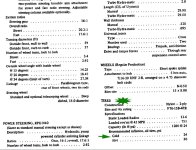Tire pressure setting can create or solve under or oversteer
So staggering tire pressures, front/rear or left/front is a simple no cost way to correct or if on a track bias direction
Also, other ways to correct or bias under/oversteer
Oversteer
Rear tire drift is greater than that of the front, and the rear tends to “spin out.”
The vehicle will end up closer to the center of the circle because the rear tire drift changes the direction inward.
Or, simply: Oversteer takes place when a car turns more than the amount commanded by the driver.
Oversteer is common in rear-wheel-drive cars and generally caused by a lack of traction at the rear tires.
When you break loose, oversteer is occurring.
Ways to Correct Oversteer
- Lower front tire pressure
- Raise rear tire pressure
- Stiffen front shocks
- Soften rear shocks
- Raise front end
- Lower rear end
- Install narrower front tires
- Install wider rear tires
- Stiffen front sway bar
- Soften rear sway bar
- Reduce front negative camber
- Reduce positive caster
- Stiffen front springs
- Soften rear springs
Understeer
Front tire drift causes the vehicle to refuse to turn as sharply as the direction the wheels are pointed.
If the wheels and throttle are held steady, the vehicle will make an ever-widening circle.
Or, simply: Understeer occurs when a car turns less than the amount commanded by the driver.
It’s “push” in racing lingo.
It’s a natural handing characteristic of front-wheel-drive and all-wheel-drive vehicles.
You turn the wheel, but you just go straight. Which is bad.
How do you fix it?
Ways to Correct Understeer
- Raise front tire pressure
- Lower rear tire pressure
- Soften front shocks and stiffen bump
- Stiffen rear shocks
- Lower front end
- Raise rear end
- Install wider front tires
- Install narrower rear tires
- Soften front sway bar
- Stiffen rear sway bar
- Increase front negative camber
- Increase positive caster
- Soften front springs
- Stiffen rear springs
Oversteer and understeer are more common problems in racing than in street driving.
As such, weather and track conditions, as well as varying driving styles and abilities will also play a role.
Also using air pressure to better launching from a dead stop like at a drag strip
Up the tire pressure in the front to reduce drag, lower rear pressures to create more traction off the stop/launch
to reduce the 0-60 feet times

